Angela Slatter's Blog, page 44
April 4, 2017
Aletheia: JS Breukelaar
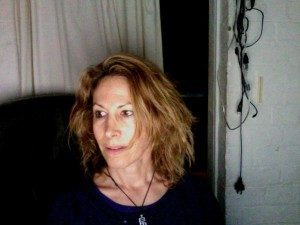 JS Breukelaar’s Aletheia is one of the finest, strangest novels I’ve read in a long time. There’s bone and blood magic in it, and it drips strangeness. Highly recommended.
JS Breukelaar’s Aletheia is one of the finest, strangest novels I’ve read in a long time. There’s bone and blood magic in it, and it drips strangeness. Highly recommended.
She’s resident of Sydney, Australia via San Diego, New York and New Zealand. Born in Berkeley, Ca. PhD’ed here in Sydney, where she writes and teaches.
Her first novel, American Monster, came out February 2014 from Lazy Fascist Books. Her work has been shortlisted or nominated for the Varuna HarperCollins Manuscript Award, the Roffey Prize, Ellen Datlow’s Best Horror List, the John W Campbell Award, the Millions Award and others, and has appeared in Juked, Prick of the Spindle, Fantasy Magazine, Go(b)et Magazine, New Dead Families, Opium Magazine, and in anthologies such as States of Terror II, Women Writing the Weird I and II, and Les Editions du Zaparogue, among others. She also writes for online literary and culture journals like The Nervous Breakdown and Pop Matters.
1. So what should new readers know about JS Breukelaar?
I’m an expat author (US born) living in Sydney with my two and four-legged family. Aletheia is my second published novel. The first was American Monster, and before that I released a small collection of short stories and poems with the author Sebastien Doubinsky’s collective, Les Editions du Zaparogue. Aside from that, I’ve published a few dozen short stories in magazines like Gamut, Lightspeed, Lamp Light and others, a handful of poems, and a bunch of essays—I’m a columnist and instructor at LitReactor.I have a PhD in Creative Writing and Film Studies and I teach literature and writing here in Sydney and overseas.
2. What was the inspiration for Aletheia? 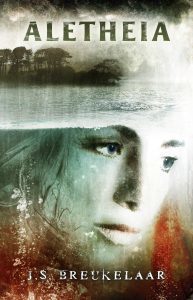
Aletheia is like one of those long love-hate letters you write to a friend or relative or someone from your past with whom it’s complicated, and you should never send, because it doesn’t resolve anything. But you send it anyway. I grew up in a small lake town like Little Ridge, and so I guess that was the first inspiration. But also memory and parenthood and loss. And the fall-out from science and art.
3. When did you first decide you wanted to be a writer? Was there a particular story you read that sparked your interest?
I can name one story in particular – Joe R Lansdale’s “Godzilla’s Twelve Step Program” that could possibly have pushed me over the edge, or maybe it was William Gibson’s “Fragments of a Hologram Rose,” or “The Belonging Kind” with John Shirley… but anyway, I was that kid who knew early on that she was going to be a writer. I had a fifth-grade teacher, who I wrote about here, to whom I owe the crystallization of that knowledge. Rob Spillman at Tin House gave me a volume called Fantastic Women, with stories by Karen Russell, Aimee Bender and Kelly Link, and these all fired me up. John Gardner’s Grendel was one of those, ‘I need to do this or die trying,” moments. Denis Johnson taught me that dialogue wasn’t for pussies and Dennis Lehane dangled perfect structure in front of my nose and I’m still chasing it. So, no, Not one particular story. I live in the shadow of them all.
4. What can you tell us about your previous novel, American Monster?
American Monster is a science-fiction horror novel about a dystopian California traversed by a daemon named Norma. Norma’s handler is a deep space entity called Mommy, and Mommy is bonkers. When Mommy was still a whole planet instead of the brain-dead black hole she is now, a winged, horned alien crash-landed on her surface and she never forgot it, and now she wants him back. So she—Mommy’s not really a she, more like an IT— sends Norma to earth to retrieve the horned alien, but anatomy was never Mommy’s strong point, and she gets the location of the horn, um, confused. So poor Norma is cursed with a predatorial sex drive, congenital loneliness and a fatal susceptibility to the human condition. In other words, she falls for earth. Hard. Beginning with a likeable screw-up called Gene, but just as critically with a street kid called Raye, who knows her way around Spill City much better and more dangerously, than any fourteen-year old should.
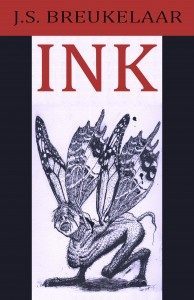 5. What scares you?
5. What scares you?
Pretty much everything.
6. Who are your literary influences?
Shirley Jackson, Seb Doubinsky, Cormac McCarthy, Joyce Carol Oates, Poe, Philip K Dick, Don DeLillo, Emily Dickinson, Allen Ginsberg, Peter Straub, King, Ray Bradbury … and more recently, Jeffrey Ford, Kelly Link, Angela Slatter, Josh Malerman, Lucy A. Snyder, Laird Barron, Karen Joy Fowler, J David Osborne, Stephen Graham Jones, Han Kang … I mean it’s hard to separate admiration from imitation. Even if my writing isn’t directly influenced by an author I admire, and often it isn’t, I’m influenced by their scope, or their vision, or their imagination or the humanity in their work.
7. Name five people you’d like to have dinner with? Dead or alive (keeping in mind that the dead ones will be cheaper dates).
You knew I was going to say Barak and Michelle, right? So that doesn’t count. Peter Straub, and Stephen King. Together of course. But I’d be puking in the bathroom, and I’d miss the whole thing and just be left with the check. So that doesn’t count either. Shirley Jackson. Prince. Miguel Cervantes. They’re the dead ones that’d make up for Straub and King.
8. Your work’s been described as “Weird” – what constitutes weird fiction for you? 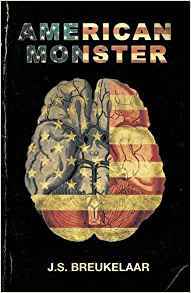
I really hesitate to say. I was surprised to be described as weird. I didn’t think I was until the word was kind of wafted in my general direction. Probably because of an uncategorisable element in my fiction due in part to my affinity with characters and desires at the edge of things. Or, in Aletheia, for instance, Nose Island that is both there and not there. I’ll take it, anyway.
If I had to say, I’d speculate that Weird fiction edges ever closer to the dread undecidable in its plot, its characters, its setting, and its unsettling resolutions. Weird fiction, like Blackwood’s “The Willows,” can be a choked-off scream, or like Kelly Link’s “The Hortlak,” be a dense-dark fantasy that makes you smile when you want to cry or like Stephen Graham Jones’s “Little Lambs,”find a chilling connection in the void. So for me, The Weird tends to inhabit a zone just outside of fear and tainted by a strange lovesickness—just beyond the campfire ring, but not quite at the edge of the forest—a place where you were always headed, and from which there’s no turning back, not because you can’t but because maybe you don’t want to.
9. Your favourite heroine? Your favourite villain?
One of my favorite heroines is Shirley Jackson’s Eleanor from The Haunting of Hill House, Jeffrey Ford’s Emily Dickinson from his story, “A Terror,” and Josh Malerman’s Malorie, from Bird Box. Villains – that’d have to be Judge Holden from McCarthy’s Blood Meridian.
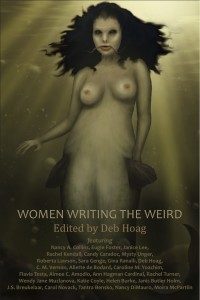 10. What’s next for JS Breukelaar?
10. What’s next for JS Breukelaar?
I’m late with a collection of short stories also for Crystal Lake Publishing. I have a couple of stories dropping in Gamut and an anthology called Welcome to Dystopia later in the year. There is a collaborative thingie in the works with a great author-friend of mine I can’t talk about right now. I’m working on another collection and concentrating on writing the stories for that. And in July I begin a new novel.
April 3, 2017
Corpselight: stuff’s getting real!
So, the big banner arrived today, all shiny and bright for the launch (complete with dog bowls and thongs – that’s my thongs (or flip-flops if you’re of the bent to willfully misunderstand what Australia footwear is), not those belonging to the dogs)!
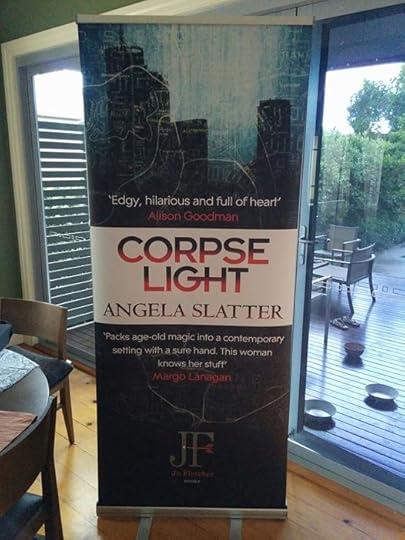
March 30, 2017
Gamut: Day of Reckoning
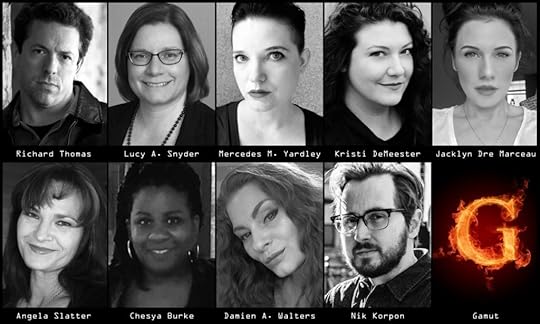 So, I’ll be one of the teachers for Gamut’s Day of Reckoning intensives.
So, I’ll be one of the teachers for Gamut’s Day of Reckoning intensives.
One intense day with eight talented authors and teachers, plus feedback on up to eight different stories. All for only $350. Click on over and check it out, the classes will be small, up to eight students. This should be a lot of fun. Honored to work with each and every one of these authors. For more details http://gamut.online/node/176
March 28, 2017
The Kissing Booth Girl and Other Stories: A.C. Wise
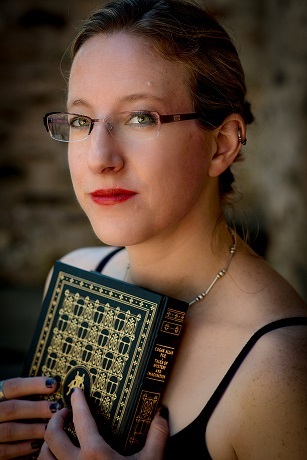 A.C. Wise was born and raised in Montreal and currently lives in the Philadelphia area. Her short stories have appeared, or are forthcoming, in publications such as Clarkesworld, Uncanny, Tor.com and The Year’s Best Dark Fantasy and Horror 2017, among other places. Her collections, The Ultra Fabulous Glitter Squadron Saves the World Again, and The Kissing Booth Girl and Other Stories, are both published by Lethe Press. In addition to her fiction, she co-edits Unlikely Story, and contributes a monthly review column to Apex Magazine. Her Women to Read and Non-Binary Authors to Read series can be found at www.acwise.net, along with various other odds and ends. You can also find her on twitter as @ac_wise, most often shouting about excellent short fiction.
A.C. Wise was born and raised in Montreal and currently lives in the Philadelphia area. Her short stories have appeared, or are forthcoming, in publications such as Clarkesworld, Uncanny, Tor.com and The Year’s Best Dark Fantasy and Horror 2017, among other places. Her collections, The Ultra Fabulous Glitter Squadron Saves the World Again, and The Kissing Booth Girl and Other Stories, are both published by Lethe Press. In addition to her fiction, she co-edits Unlikely Story, and contributes a monthly review column to Apex Magazine. Her Women to Read and Non-Binary Authors to Read series can be found at www.acwise.net, along with various other odds and ends. You can also find her on twitter as @ac_wise, most often shouting about excellent short fiction.
1. First of all, what do new readers need to know about A.C. Wise?
Let’s see. I’m primarily a short fiction writer. I enjoy playing around with various sub-genres, but most of my work tends towards the dark and the weird. I have two short story collections out from Lethe Press, one a collection of interconnected stories titled The Ultra Fabulous Glitter Squadron Saves the World Again, and the other a more traditional short story collection mixing reprints and a few originals titled The Kissing Booth Girl and Other Stories. On the non-writing side of things, I have two adorable corgis whose pictures frequently show up on Instagram and Twitter. Alas, my adorable kitten rarely stays still long enough for pictures. Also, I’m Canadian.
2. Your Women to Read lists are invaluable – how do you go about finding all those stories? And the time to read!
I’m so glad you enjoy them! I love helping folks find new-to-them authors, and pushing myself to discover new-to-me authors and works as well. The Women to Read and Non-Binary Authors to Read series are a perfect excuse to do both. As for finding the time, I’m lucky enough – or unlucky enough, depending on your perspective – to have a long train commute to and from work. It’s about an hour each way, so I get a lot of reading done!
3. What was the process for putting together your collection The Kissing Booth Girl and Other Stories? 
I chose a lot of the stories based on my personal favorites. I also tried to get a mix of older and newer works, and things that might have had a narrower distribution in their original publication. I wanted the collection to be an overview of sorts, a representative sampling of my work.
4. What does your work day look like – where do you fit everything in?
My day job also involves writing, but of a different kind, grantwriting for a museum. Even though it’s still putting words on a page, it engages a different part of my brain, so I have yet to burn out. In a way, it’s been helpful in terms of learning to brutally cut and slash to fit within restrictive word counts. As much as I might love a sentence, sometimes I just have to let it go. As for creative writing, I do my best to fit in at least a little bit of writing or editing on my lunch hour, and I can usually get a few solid hours in on weekends, which is always lovely. Of course, it doesn’t always work out that perfectly, but I do my best.
5. What was the inspiration behind “When the Stitches Come Undone” in Children of Lovecraft?
It was one of those rare (for me at least) stories where the title came first. It popped into my head, and I immediately started wondering where the stitches were, what they were holding together, and of course, what happened when they came undone. As the story unfolded, the themes I most wanted to explore were the ideas of seeing and being seen, sacrifice, and consumption and being consumed as an act of love, if rather twisted one. Hopefully it all worked!
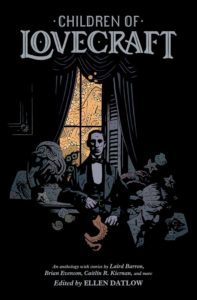 6. What do you like about writing Lovecraftian fiction?
6. What do you like about writing Lovecraftian fiction?
There’s something weirdly appealing about the notion of a vast and uncaring universe, cosmic horror that rolls right over humanity without even realizing it’s there. The fact that many of Lovecraft’s monsters, and monstrous geographies, are meant to be indescribable or incomprehensible to the human mind is another appealing aspect. It leaves room for the imagination. Obviously Lovecraft has his problematic elements, so there’s also joy in reclaiming his spaces and populating them with women, queers, people of color, and other marginalized folk either left out or actively demonized in his original writing.
7. Can you remember the first story you read that made you think “I want to be a writer”?
I can’t remember a specific story, but I remember reading Ellen Datlow and Terri Windling’s fairy tale anthologies and thinking “yes, I want to write that”. Retold fairy tales were some of the earliest works I managed to get published. Retold fairy tales can be an excellent training ground for a new author. Seeing how stories work, taking familiar elements and breaking them apart to build something new is a great way to learn how stories work, and a good jumping off point for learning to tell stories of your own. At least that’s how it worked for me. The framework of a known tale was a safe place to try out new styles and voices and find my way into the kind of stories I wanted to tell.
8. Which five writers have been your biggest influences?
Agh! That’s a tough question. Ray Bradbury is certainly one of them. I fell in love with his work at just the right age, and I don’t think I’ll ever get over that love and the way it’s influenced my own work. Caitlin Kiernan and Jeff VanderMeer are certainly in the mix as well for their style, their darkness, the way they both have a knack for hinting at hidden depths and larger worlds than what is on the page. Even though they’re very different writers, various of their works have filled me with a sense of creeping unease and dread that I can’t quite put a finger on, but aspire to in my own writing. I’m also constantly inspired and influenced by the writers around me publishing new work today – some I’ve been lucky enough to meet at conventions, or interact with online, or share tables of contents with, and some I simply admire from afar. (There, I either cheated and included far too many authors, or two few, depending on how you count.)
9. You can take five books to a desert island: which ones do you choose? 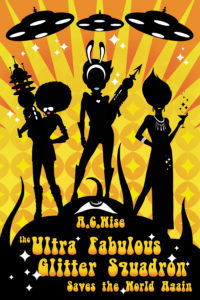
Only five?! What a cruel question! Is there a Tardis equivalent of a book that hides other books inside it, and keeps unfolding new things to read as they’re required by the reader? If not, I couldn’t possibly choose. I have old favorites of course, but then think of all the new things I’d be missing out on! Clearly I’ll just have to go to a desert island with a library on it. Or maybe I should just be practical and say I’d take things like A Guide to Building Boats with Limited Resources, Shelters and You, and Spear-Fishing for Dummies, assuming this is the sort of island I’m stranded on, where I need to use my wits to survive.
10. What’s next for A.C. Wise?
I have a handful of stories coming out in 2017, and I’m working on a handful more. I’ll continue writing my Words for Thought review column for Apex, along with Women to Read, and Non-Binary Authors to Read for my blog. As for the next big project…well, I have settled on that yet. Ideas are percolating, but I haven’t committed to one yet. I’m bad at decisions. (See the two questions above for evidence!)
March 21, 2017
Strictly No Elephants: Lisa Mantchev
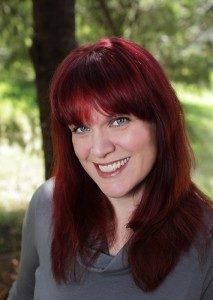 Lisa Mantchev is a temporally-displaced Capricorn who casts her spells from an ancient tree in the Pacific Northwest. When not scribbling, she is by turns an earth elemental, English professor, actress, artist, and domestic goddess. She shares her abode with her husband, two children, and three hairy miscreant dogs. She is best known as the author of the young adult fantasy trilogy, The Théâtre Illuminata, which includes the Andre Norton and Mythopoeic awards-nominated EYES LIKE STARS. Her steampunk young adult novel, TICKER, was a Kindle #1 Bestseller, and her picture book, STRICTLY NO ELEPHANTS, was named a 2016 NCTE Charlotte Huck Award Honorable Mention. Lisa’s short fiction has also appeared in venues like Faerie Magazine, Clarkesworld, Weird Tales, Fantasy Magazine, and Strange Horizons.
Lisa Mantchev is a temporally-displaced Capricorn who casts her spells from an ancient tree in the Pacific Northwest. When not scribbling, she is by turns an earth elemental, English professor, actress, artist, and domestic goddess. She shares her abode with her husband, two children, and three hairy miscreant dogs. She is best known as the author of the young adult fantasy trilogy, The Théâtre Illuminata, which includes the Andre Norton and Mythopoeic awards-nominated EYES LIKE STARS. Her steampunk young adult novel, TICKER, was a Kindle #1 Bestseller, and her picture book, STRICTLY NO ELEPHANTS, was named a 2016 NCTE Charlotte Huck Award Honorable Mention. Lisa’s short fiction has also appeared in venues like Faerie Magazine, Clarkesworld, Weird Tales, Fantasy Magazine, and Strange Horizons.
1. First of all, what do new readers need to know about Lisa Mantchev?
I write a lot of nonsense. One reviewer even called it “an overabundance of nonsense” which I then had turned into an embosser and used it on gold seals to put on the cover of my steampunk novel.
2. What projects are you working on right now? 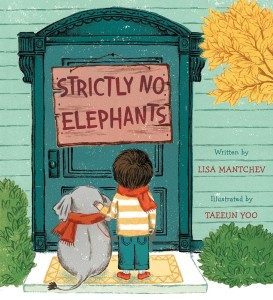
I just finished adapting my first picture book, STRICTLY NO ELEPHANTS, into a theatrical script, aided by my longtime writing-partner-in-crime, Glenn Dallas. We’ll be doing full puppet builds for the animals and using them for my children’s theater class, which will then become the season-opening production for Olympic Theatre Arts in Sequim, WA.
I’m also working on the third book in the LOST ANGELES series. That is my “smut for grown-ups” urban fantasy series that I write with A.L. Purol. And, as ever, there are about six different writing projects on the backburner, simmering away.
3. Which book, either fictional or otherwise, would you say taught you the most about writing?
It’s a tie between “Biting the Sun” by Tanith Lee and Terry Pratchett’s Discworld series, for fiction. One taught me that science fiction could be pretty, and the other taught me to go for the joke. My half of SUGAR SKULLS is actually dedicated to Terry. On Writing by Stephen King is my go-to craft and process book.
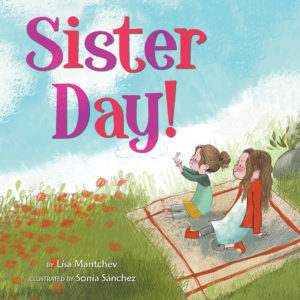 4. How did you end up doing these gorgeous picture books?
4. How did you end up doing these gorgeous picture books?
Completely by accident. I saw an internet meme of a black and white photograph of a child standing in front of a door… she has a little elephant pull-toy, but the sign says “STRICTLY NO ELEPHANTS.” It sparked a mini-story that I posted in a thread for fun on my Facebook fan page. Everyone was very enthusiastic about it, insisting it should be turned into a book for children, so I sent it to Laura Rennert, my literary agent. Her response was “take that off the internet immediately.” Then it found at home with Sylvie Frank at Paula Wiseman.
5. What was the inspiration for Sugar Skulls? 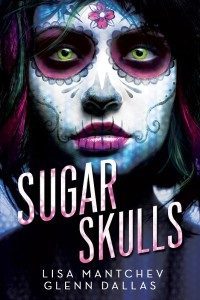
Originally, I had an idea for writing a story in the round with four writers, each of us taking a character in a rock band. I contacted Glenn Dallas, whom I have known for years, and asked him, “Hey, how much do you know about guitar?” His response was “not a goddamn thing, but I’m in.” After a week, he and I had brainstormed so much in a Google document that the other two writers felt we should move ahead without them.
6. You’ve collaborated on YA and adult books – how does that process work for you?
It always starts with “let’s do a thing.” Seriously. I love working with people who challenge me, and there’s something hugely exciting about collaborative energy, never mind the magic of waking up in the morning to find that words have MAGICALLY APPEARED in the work-in-progress overnight.
With both Glenn and Amanda, we work in Google documents and each have assigned characters on which we have “the final word.”Glenn and I work more section-by-section, while Amanda and I write over the top of each other. Both of them are stronger plotters than I am, and I usually spend a lot of time on editorial things. It’s a good balance of strengths, at the end of the day, and like a marriage in a lot of ways. I know there are times when we would have all cheerfully murdered each other, if we weren’t several thousand miles away and lacking an alibi. Seriously, ask Glenn how he feels about the phrase, “this needs to be more conversational.” And be prepared to duck.
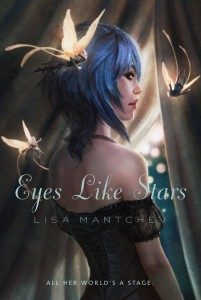 7. Can you remember the first story you read that made you think “I want to be a writer”?
7. Can you remember the first story you read that made you think “I want to be a writer”?
I don’t think I ever made that decision consciously, because I’ve been writing short stories since I was in third grade. I was also doing community theater from the time I was seven, so I was getting a lot of my formative process from reading scripts (mostly musicals.) I adapted pieces of Little House on the Prairie and The Blue Bird for school plays as well, so I think it’s more of a “I was already in the water when I decided to swim” sort of scenario.
8. When you’re in the mood to read, who do you choose?
Old favorites… they are like comfort food. Anne of Green Gables or any of L.M. Montgomery’s work, really. The Shoes series by Noel Streatfeild. A Tree Grows in Brooklyn. A lot of classic young adult, now that I think about it. And I love a good romance novel. The first few books in the Outlander series were lovely.
9. You get to invite five fictional characters to dinner: what’s your guest list look like? 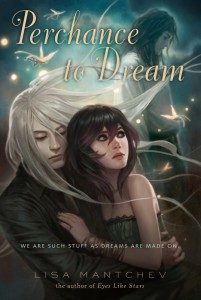
Susan StoHelit, from Soul Music, etc.
Howl Pendragon, from Howl’s Moving Castle
Jamie Fraser, from Outlander
Tom Hiddleston’s F. Scott Fitzgerald from Midnight in Paris (Data point: I will note that I hated quite a lot of this movie and didn’t know it was a Woodie Allen flick until afterward, otherwise I would have skipped it, because blech.)
Totoro, from My Neighbor Totoro (I want to nap on his tummy.)
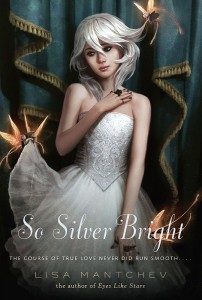 10. What’s next for Lisa Mantchev?
10. What’s next for Lisa Mantchev?
A LOT of shenanigans. I have back-to-back children’s theatre classes booked through Halloween—first we do a masquerade class, then stage STRICTLY NO ELEPHANTS, then jump straight into the Haunted House—and on the writing side, I have two more picture books coming out this year. SISTER DAY! is illustrated by Sonia Sánchez and tells the story of a little sister who just wants her big sister to have the time to play with her. That comes out in June. And a follow-up, tie-in, but-not-a-sequel to STRICTLY NO ELEPHANTS is coming out in the fall. It’s titled SOMEDAY, NARWHAL and is illustrated by Hyewon Yum. In this one, we get to revisit several of the animals in the unusual pet parade, and see how they work together to help their friend realize her dream of seeing the world.
March 20, 2017
Mad Hatters and March Hares – Cover Art
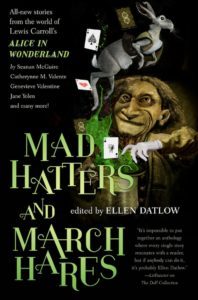 Huzzah! Final cover art for the new Ellen Datlow anthology, Mad Hatters and March Hares, which contains stories inspired by the Alice mythos.
Huzzah! Final cover art for the new Ellen Datlow anthology, Mad Hatters and March Hares, which contains stories inspired by the Alice mythos.
Table of Contents
“A Comfort, One Way” by Genevieve Valentine
“Alis” by Stephen Graham Jones
“All the King’s Men” by Jeffrey Ford
“Conjoined” by Jane Yolen
“Eating the Alice Cake” by Kaaron Warren
“Gentle Alice” by Kris Dikeman
“In Memory of a Summer’s Day” by Matthew Kressel
“Lily-White & The Thief of Lesser Night” by C.S.E. Cooney
“Mercury” by Priya Sharma
“Moon, Memory, Muchness” by Katherine Vaz
“My Own Invention” by Delia Sherman
“Run, Rabbit” by Angela Slatter
“Run, Rabbit, Run” by Jane Yolen
“Sentence Like a Saturday” by Seanan McGuire
“Some Kind of Wonderland” by Richard Bowes
“The Flame After the Candle” by Catherynne M. Valente
“The Queen of Hats” by Ysabeau Wilce
“Worrity, Worrity” by Andy Duncan
Corpselight cover
Here’s the wraparound – and the praise (I like the praise)!

Praise for Corpselight
“The Fassbinder fun continues. The only-half-Normal Brisbane sleuth has fox-spirits, ninja librarians and much, much worse to deal with now, even as motherhood gives her a makeover. Slatter’s dark imaginings, spritzed with humour, pack age-old magic into a contemporary setting with a sure hand. This woman knows her stuff.”
— Margo Lanagan, award-winning author of Sea Hearts, Tender Morsels, Black Juice
“Edgy, hilarious and full of heart – Verity is back and as brilliant as ever!”
— Alison Goodman, award-winning author of Lady Helen and the Dark Days Club
“Angela Slatter’s ink is full of intimate magic and hard wisdom. Her characters live and breathe and glance out at you from the page to question your motives. One of the best dark fantasy writers working today.”
—Christopher Golden, New York Times bestselling author of Ararat and Snowblind
March 19, 2017
April Sneak Peek at Patreon
 Over at Patreon, there’ s a little taste of next month’s reward for Monkshoods and above.
Over at Patreon, there’ s a little taste of next month’s reward for Monkshoods and above.
March 15, 2017
Book Launch: The Quarters
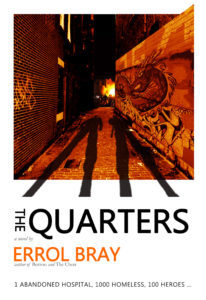 Not my book, no, but I am launching Dr Errol Bray’s new novel, The Quarters, at Avid Reader tonight. Details below – remember to book.
Not my book, no, but I am launching Dr Errol Bray’s new novel, The Quarters, at Avid Reader tonight. Details below – remember to book.
Prize-winning author Errol Bray’s novel The Quarters imagines an “uncivil” war with 300,000 homeless vs the rest of Sydney. The Quarters – the new novel by prize-winning author Errol Bray, from Melbourne publisher, Clouds of Magellan – is now in bookshops and on Amazon.
The book is a fast-paced, thriller-style story full of misadventure, political intrigue, street violence and love stories, set in the inner-city lanes of Sydney.
Internationally acclaimed Brisbane author Angela Slatter is in-conversation with Errol Bray for the launch of his latest novel.
Book launch: Thursday 16 March 2017, 6.00PM at Avid Reader Bookstore, 193 Boundary Street, West End, BRISBANE. Bookings essential on http://avidreader.com.au/events/errol... or (07) 3846 3422
March 14, 2017
Shadows & Tall Trees 7: Malcolm Devlin
 Malcolm Devlin’s stories have appeared in Black Static, Interzone and Nightscript as well as the anthologies Aickman’s Heirs and Gods, Memes and Monsters. His collection, You Will Grow Into Them will be published by Unsung Stories in June 2017.
Malcolm Devlin’s stories have appeared in Black Static, Interzone and Nightscript as well as the anthologies Aickman’s Heirs and Gods, Memes and Monsters. His collection, You Will Grow Into Them will be published by Unsung Stories in June 2017.
1. What inspired your story “We Can Walk It Off Come The Morning” in Shadows & Tall Trees 7?
I probably shouldn’t admit this, but “We Can Walk It Off Come The Morning” is perhaps around 60% true. On New Year’s Day a few years back, I was part of a group of friends who — while horribly hungover — thought it a good idea to hunt down a particular standing stone, somewhere on the Barra Peninsula. Pretty much everything else is different, including all the characters. We all got home perfectly safely and spent the evening eating leftovers, which isn’t very frightening it retrospect, but I remember that at some point in the silent fog, I did find myself questioning whether we’d all become unstuck in time somehow.
2. Can you recall the first story you ever read that made you think ‘I want to be a writer!’? 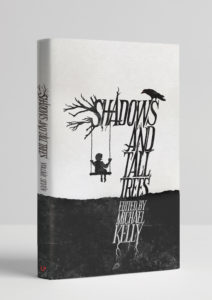
I don’t think it was ever one particular story or author, more a gradual accumulation over the years. Despite growing up on a diet of Roald Dahl, Susan Cooper and Alan Garner, the first actual horror stories I remember reading were from a collection called Nasty by Michael Rosen. I must have been around eight or so, and the cover showed an illustration from the first story, involving a giant man-eating flea that was terrorising the Bakerloo Line in London. The one that stuck with me, though, was called “The Loaf And The Knife” and involved a genuinely unpleasant solution to rodent control. It was unsettling stuff, but I appreciated the way it stayed with me and I suspect it might have steered my reading from then on.
3. What scares you?
Doorways.
I specifically mean open, empty doorways that stand between a warm, brightly lit room and a cold dark hallway, yard, corridor or street.
Let me give you an example: It’s late, and you’re almost ready for bed, but you’ve got chores that need your attention. Behind you, the door stands open, and through it, there’s the unlit landing and the lip of the stair leading down to the lounge.
There’s nothing else, because for whatever reason you care to contrive, you’re all alone tonight.
Something a little bit wrong makes you turn around. It’s probably nothing. A sound maybe, or the sense that shifts your perception of the sound to the wrong context.
 So you turn round and … well, there’s nothing there, of course. Just that gaping doorway, the landing, the stair. Nothing there at all. So you turn back to your work, satisfied you’re still alone.
So you turn round and … well, there’s nothing there, of course. Just that gaping doorway, the landing, the stair. Nothing there at all. So you turn back to your work, satisfied you’re still alone.
Only of course, you’re not satisfied. You haven’t heard anything else, so why is it that you want to look again? Why is part of you convinced that if you turn back, you’ll see something framed in that doorway? A figure maybe, indistinct, all shape and shadow and silence and nothing else. Still and patient on the other side. Waiting.
And so you look again. And of course there’s nothing there. Only the landing and the top of the stair. All that space that something could occupy but doesn’t.
And that’s why I don’t like open doorways. Because sometimes I’m frightened they don’t show me what’s really there, and sometimes I’m frightened that one day, they will.
Also, Twitter. Obviously.
4. You can take five books to a desert island: which ones do you choose?
Only five? Oh come on. Who escapes a sinking ship with only five books?
Let’s see. The Gormenghast books by Mervyn Peake, Hard Boiled Wonderland and the End of the World by Haruki Murakami, The Bloody Chamber by Angela Carter, The Owl Service by Alan Garner, Midnight’s Children by Salman Rushdie. Also everything ever written by Kelly Link, which I insist should be available in one volume before I allow myself to be in a situation where I might get shipwrecked with a strict book limit.
(If this looks like more than five books, then some of them might have got stapled together. I hear such things happen sometimes.)
5. What’s next for you? 
I have a collection called You Will Grow Into Them. It’ll be published by Unsung Stories, and is due in June which is both exciting and — a little like one of those open doorways — inexplicably terrifying.



